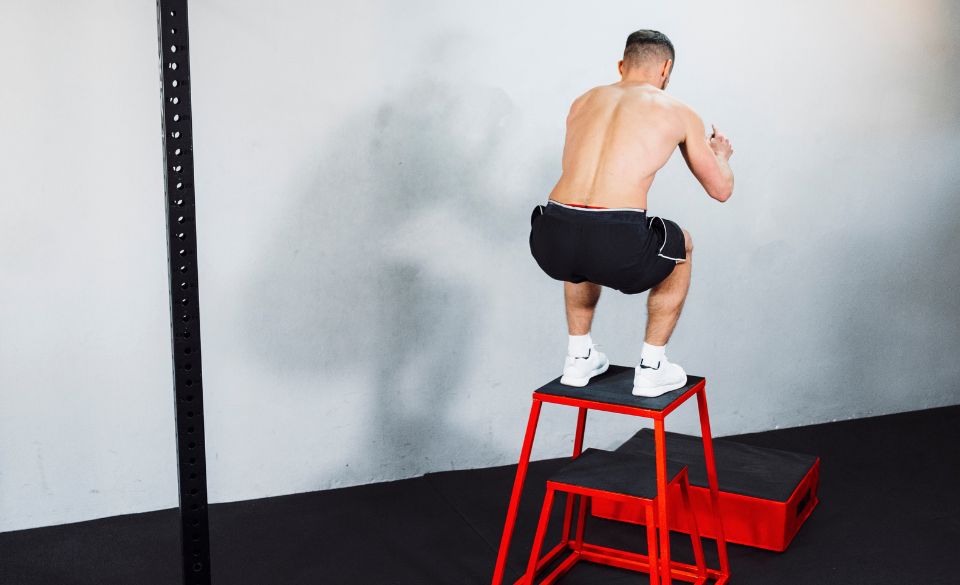
Plyometric Training For Runners: A Complete Guide
Page Contents
- Understanding Plyometric Training
- The Science Behind Plyometric Training
- Benefits of Plyometrics for Runners
- Determining Sets and Reps
- Frequency of Plyometrics
- Incorporating Plyometrics into Your Running Plan
- Common Mistakes in Plyometric Training
- Recommended Plyometric Exercises for Runners
- Incorporating Plyometrics
- Final Words – Plyometric Training For Runners
Plyometric training stands as a well-regarded approach within the realm of strength and conditioning, aimed at enhancing power output. While running is not inherently considered a power sport, it does rely on repetitive and forceful contractions, especially during high-speed or uphill running. This article delves into the scientific underpinnings of plyometric training, its potential benefits for runners, and strategies for incorporating plyometric exercises into your training regimen.
Understanding Plyometric Training
The core objective of plyometric training revolves around augmenting a muscle’s capacity to generate substantial power, characterized by a combination of formidable force and rapid speed. To accomplish this objective, individuals engage in swift and forceful exercises, commonly referred to as plyometrics. It’s important to note that plyometric exercises are not merely fast and explosive; they must encompass the stretch-shortening cycle to be effective. This cycle, a physiological concept, entails the active lengthening of a muscle, swiftly followed by an active contraction. The energy stored during the muscle’s lengthening phase is subsequently harnessed to yield increased power during the contraction.
It’s imperative to distinguish plyometric training from High-Intensity Interval Training (HIIT). The primary aim of plyometrics is not to attain a cardiovascular workout, so it’s unwise to rush through repetitions or skip essential rest intervals. Furthermore, engaging in high-repetition plyometric exercises should be avoided. Instead, plyometric routines emphasize rapid landings and potent jumps, skips, or bounds.
The Science Behind Plyometric Training
At the heart of plyometric training lies the stretch-shortening cycle (SSC), a neuromechanical phenomenon capable of producing significant power. This cycle constitutes the fundamental mechanism that renders plyometric exercises unique and effective, comprising three distinct phases: eccentric, amortization, and concentric.
In the eccentric phase, the targeted muscle undergoes rapid stretching, leading to the storage of elastic energy within the musculo-tendinous unit’s series elastic component. Simultaneously, this quick stretch stimulates muscle spindles, triggering a reflex that amplifies muscle activity, thereby increasing force generation.
The amortization phase follows, characterized by a brief pause subsequent to the eccentric phase and preceding the final concentric phase. During this fleeting amortization period, the muscle spindle reflex sends signals via afferent nerves to the alpha motor neurons within the spinal cord. These neurons transmit messages back to the muscle, triggering a reflex response that releases stored elastic energy.
In the concluding concentric phase, the stretch reflex actively contributes to the muscle’s action, such as a jump. The elastic energy is then translated into greater muscular force as movement occurs. It’s worth noting that if no movement transpires or if there is a significant delay, the stored elastic energy dissipates as heat.
Plyometric training serves to enhance all of these mechanical and neuromuscular mechanisms, enabling individuals to generate increased power within the stretch-shortening cycle over time.
To illustrate this concept, consider the jump squat: during this exercise, a rapid squatting motion characterizes the eccentric phase, followed by a powerful jump from the squat position in the concentric phase. In practice, the amortization phase is notably brief, and there is no extended pause between phases during the execution of a jump squat.
Benefits of Plyometrics for Runners
The running stride can be essentially perceived as a sequence of horizontal and slightly vertical plyometric movements, varying in intensity. Therefore, it is theoretically plausible that plyometric training could enhance running performance. However, let’s delve into the scientific findings.
Plyometric training indeed offers advantages for long-distance runners. A comprehensive review in Sports Medicine in 2015 revealed that plyometric training contributes to improved running economy, primarily through the enhancement of neuromuscular mechanisms. This is particularly significant considering the multifaceted nature of running economy. In a 2016 review published in the Journal of Strength and Conditioning, researchers explored the impact of strength training on runners and found that combining strength training with plyometrics enhanced running economy. It’s important to note that this combined approach, known as complex training, was integrated into an 8-12 week program concurrently with running training. Improved running economy translates to faster running speeds at submaximal efforts.
A 2022 review in Sports Medicine observed that elite runners typically incorporate small doses of plyometric training, performed twice a week, during the early and mid-preparation phases of their training. These plyometric exercises include activities like skips, bounds, hill sprints, and squat jumps. As athletes transition into the competition phase, they often reduce plyometric sessions to once a week or even eliminate them altogether. Consequently, plyometric training is not a weekly fixture, especially as race day approaches.
Determining Sets and Reps
When embarking on plyometric training, it’s essential to strike a balance between exertion and recovery. Plyometrics become less effective as fatigue sets in, rendering high-repetition schemes counterproductive. Attempting to complete 10-15 sets may, at best, prove time-consuming and, at worst, elevate the risk of injury. The National Strength and Conditioning Association recommends adhering to a rep scheme akin to power exercises. Ideally, you should aim for 3-6 sets of 2-5 repetitions per exercise if you’re pursuing a plyometric-exclusive workout. In the context of combining plyometrics with strength training, consider performing 1-6 sets of 4-6 reps, focusing on 1-2 exercises, particularly when synchronized with your running regimen.
For novices entering the realm of plyometric training, it’s prudent to commence with lower sets and repetitions. Plyometric training volume is quantified based on the number of foot contacts. Beginners should aim for approximately 80-100 contacts per session. As you progressively build experience and proficiency, you can gradually elevate the volume to around 120 contacts per session. Your choice of sets, reps, and exercises should align with the designated volume.
Adequate rest intervals between sets are pivotal, with recommended work-to-rest ratios ranging from 1:5 to 1:10. This translates to, for instance, 50-100 seconds of rest following 10 seconds of performing a plyometric exercise. However, in cases involving high-intensity exercises such as depth jumps or activities with step-down recovery like box jumps, a shorter rest interval of 5-10 seconds between sets is advisable.
Frequency of Plyometrics
Allowing for sufficient recovery is crucial when integrating plyometrics into your training routine. A minimum of 48 hours of recovery should separate each plyometric session. This recovery period can be influenced by other workouts you undertake in addition to plyometrics, such as interval training. During the off-season or base phase, you can incorporate more frequent plyometric sessions, perhaps up to three times per week. In contrast, during race-specific training, it may be necessary to limit plyometric sessions to once or twice per week.
Incorporating Plyometrics into Your Running Plan
The timing of plyometric exercises within your running plan is pivotal. It is advisable to avoid performing plyometrics immediately after a run. Endurance exercise, like running, can diminish muscle tension and temporarily compromise power production, making it less than ideal for plyometric training. Instead, consider scheduling plyometrics before a run when you are still fresh; plyometrics typically do not negatively affect performance during an easy run. However, it’s crucial to refrain from incorporating them before demanding sessions like hill workouts, interval training, tempo runs, or other high-force production workouts.
For many runners, incorporating a separate weekly plyometric session might not be practical, given the combination of running and strength training already demanding time and effort. In such cases, complex training emerges as a viable strategy, merging resistance training and plyometrics into a single session. Essentially, complex training involves integrating one to three plyometric exercises into your strength workout.
Common Mistakes in Plyometric Training
1. Protracted Amortization Phase: Spending too much time between the eccentric and concentric phases can lead to the loss of elastic energy. This is a common mistake, particularly among runners with a predominance of slow-twitch muscle fibers. It’s advisable to initiate plyometric training with low reps and meticulous attention to technique.
2. High Repetitions with Insufficient Rest: It’s essential to remember that plyometric training differs from High-Intensity Interval Training (HIIT). The objective is not to elevate your heart rate significantly. The aim is to enhance power, not cardiovascular fitness.
3. Adding Weights to Plyometrics: Unless you possess advanced experience and are working under the guidance of a strength and conditioning coach, it’s prudent to stick to bodyweight exercises. In plyometrics, technique and rapid movement carry more weight than external load.
4. Starting Too Aggressively: As with running, diving into high-intensity plyometrics prematurely can be a recipe for injury. Begin with low-intensity plyometrics such as skips and bounds to build a solid foundation.
5. Inappropriate Footwear: While engaging in plyometric exercises, avoid highly cushioned running shoes or going barefoot. Firm lifting shoes are the preferred choice. If faced with a choice between running shoes and barefoot training, opt for running shoes to minimize the risk of injury.
6. Inadequate Surface: Plyometrics should be performed on suitable surfaces such as grass, rubber gym mats, or tracks to minimize impact and reduce the risk of injury.
Recommended Plyometric Exercises for Runners
When incorporating plyometric exercises into your training regimen, it’s crucial to align them with the demands of your sport. While there exist upper body plyometrics, runners stand to gain the most benefit from lower body plyometrics. Lower body plyometrics encompass exercises like jumps in place, standing jumps, bounds, and box jumps.
However, a word of caution is warranted when considering depth jumps (jumps off a box). These exercises are of high intensity and require a certain level of expertise in plyometrics. For runners, the impact associated with depth jumps, coupled with the existing high-impact nature of running, may pose an elevated risk of injury. It is advisable to approach such advanced exercises with care.
To commence your plyometric journey, it’s advisable to start with low-intensity, safe plyometric choices. As you gain proficiency and confidence, you can gradually incorporate more advanced exercises like box jumps.
As previously emphasized, integrate plyometric exercises as part of your overall strength training routine. Commence with 1-3 sets of 3-5 reps for a single exercise, with the option to repeat on the other leg if it’s a single-leg exercise. Focus on executing these exercises with a light and swift landing. As your capabilities progress, consider increasing the number of sets and reps or introducing additional exercises to reach a total of 120-140 foot contacts per session.
It’s essential to refrain from engaging in plyometrics under the following conditions:
1. Active Muscle or Bone Injury: Plyometrics are not recommended if you are currently dealing with an active muscle or bone injury.
2. Orthopedic Conditions: Individuals with orthopedic conditions like osteoporosis or joint degeneration should exercise caution and consult a healthcare professional before engaging in plyometric training.
3. History of Knee Surgery: If you have a history of knee surgery, it’s advisable to avoid single-leg plyometrics until you have received clearance from a medical professional.
Squat Jumps
1. Stand with your feet shoulder-width apart.
2. Lower your body into a squat position, ensuring that your thighs are slightly above parallel to the floor.
3. You can either interlock your hands behind your head or extend your arms forward to maintain balance.
4. In an explosive motion, jump upward, fully extending your legs.
5. Upon landing, aim for a soft and immediate re-initiation of the jump.
6. Repeat the exercise in a continuous fashion.
Single-Leg Hops
1. Begin by standing on one leg, keeping the other leg bent at the knee to elevate it off the ground.
2. Initiate a slight countermovement by gently lowering your body closer to the ground.
3. Without shifting your position forward, backward, or sideways, explosively propel yourself upward.
4. Return to the initial starting position as you land and promptly proceed to repeat the exercise.
Skater Hops
1. Stand on your right leg, maintaining a slight bend in the knee. Simultaneously, bend your left knee to elevate it off the ground.
2. Begin with a subtle countermovement, lowering your body slightly toward the ground.
3. Propel yourself laterally, leaping to your left side. Upon landing, ensure that your left leg bears the weight.
4. Swiftly transition to the right side, bounding and landing on your right leg.
5. Coordinate your arm movement by extending the left arm forward during the right-side landing and vice versa. This contralateral arm movement assists in maintaining balance.
Hill Sprints
Hill sprints, while not your conventional plyometric exercise, yield comparable results. Much like plyometrics, hill sprints demand a significant power output, specifically against gravity, and encompass the crucial stretch-shortening cycle. Engaging in hill sprints can enhance the suppleness of muscles and tendons in the lower limbs. These adaptations contribute to heightened mechanical power output and overall running economy. To attain a genuine plyometric impact, hill sprints should adhere to a concise duration (approximately 8-20 seconds) and demand near-maximum effort, coupled with ample recovery periods lasting 1-2 minutes.
Incorporating Plyometrics
When introducing plyometrics into your training regimen, it’s prudent to do so gradually as a component of your resistance training routine. Begin with one to two carefully selected exercises, commencing with 1-2 sets of 3-5 repetitions, allowing for ample recovery between sets. Should you decide to incorporate plyometrics, it’s essential to align their inclusion with your running schedule. Emphasizing proper technique and thoughtful programming is paramount for achieving effective plyometric training outcomes tailored to runners’ needs.
Final Words – Plyometric Training For Runners
Plyometric training, often associated with strength and conditioning, proves to be a valuable tool for enhancing power output. Although running isn’t typically classified as a power sport, it necessitates forceful contractions, especially during high-speed or uphill scenarios. This article has delved into the scientific foundations of plyometric training, its potential benefits for runners, and strategies for seamlessly integrating plyometric exercises into your training regimen.
Plyometric training operates on the fundamental premise of elevating a muscle’s capacity to generate substantial power through a combination of force and speed. To achieve this, individuals engage in rapid and forceful exercises, focusing on the stretch-shortening cycle. It’s vital to recognize that plyometrics are distinct from High-Intensity Interval Training (HIIT) and emphasize quick landings and potent movements.
The scientific underpinning of plyometrics revolves around the stretch-shortening cycle, a neuromechanical phenomenon with three phases: eccentric, amortization, and concentric. This cycle plays a pivotal role in enhancing power by harnessing stored elastic energy within muscles and tendons.
For runners, plyometric training offers notable advantages, primarily through improvements in running economy, achieved by enhancing neuromuscular mechanisms. Complex training, which combines strength and plyometrics over an 8-12 week program, can significantly boost running performance.
When determining sets and reps, it’s essential to balance exertion and recovery. The National Strength and Conditioning Association recommends a rep scheme resembling power exercises, emphasizing 3-6 sets of 2-5 reps per exercise for plyometric-exclusive workouts. Novices should commence with lower sets and reps, with the volume quantified based on foot contacts.
Adequate rest intervals between sets are crucial, with work-to-rest ratios ranging from 1:5 to 1:10. The choice of rest duration depends on the intensity of the exercise.
Plyometric sessions should be spaced at least 48 hours apart to allow for proper recovery, influenced by other workouts in your routine. During the off-season or base phase, you can incorporate plyometrics up to three times per week, gradually reducing frequency as race-specific training approaches.
To optimally incorporate plyometrics into your running plan, avoid performing them immediately after a run when muscle tension is compromised. Instead, schedule plyometrics before a run, especially during easy runs, to minimize any detrimental impact on performance. For runners with packed training schedules, complex training can effectively integrate plyometrics into strength workouts.
Common mistakes in plyometric training include protracted amortization phases, high-repetition schemes with insufficient rest, adding weights prematurely, starting at high intensities, using inappropriate footwear, and choosing unsuitable surfaces.
For runners, lower body plyometrics such as jumps in place, standing jumps, bounds, and box jumps are most beneficial. Caution is advised when considering depth jumps due to their high intensity. Initiate your plyometric journey with low-intensity exercises, gradually progressing to more advanced variations.
Incorporate plyometrics as part of your resistance training routine, starting with 1-3 sets of 3-5 reps for a single exercise. Focus on maintaining proper technique and swift movements. The timing of plyometrics is essential; avoid them before demanding running sessions.
In summary, when wisely incorporated, plyometric training can significantly enhance a runner’s performance. Proper technique, gradual progression, and thoughtful programming are pivotal for deriving optimal benefits from plyometric exercises in your training regimen.



